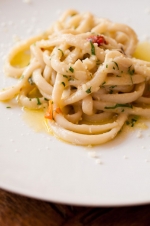Pulling Traditional Maccheroni alla Mugnaia into the Present

Recipe
Photos
If you’ve boiled a box of De Cecco, you’ve eaten the fruits of Abruzzo’s pasta making tradition—at least in its most commercial form. Due east of Rome, Abruzzo begins in the heart of Apennines mountain range and extends to the Adriatic Sea, and a combination of mountain-filtered water and close proximity to grain-producing regions makes it the ideal home for pasta making. “Most Italian chefs agree that the best pasta makers come from Abruzzo,” says 2013 Rising Star Artisan Joe Cicala, who runs the kitchen at Philadelphia’s Abruzzese restaurant, Le Virtù—though he admits chefs in Emilia-Romagna may beg to differ.
Dried pasta factories, including De Cecco, Guiseppe Cocco (Cicala’s favorite), and Del Verde, dot the region’s Del Verde River. And fresh pastas like maccheroni alla chitarra were invented there. But when Le Virtù owner, Francis Cratil-Cretarola, first experienced Maccheroni alla Mugnaia, he knew he found something special.
On the Pasta Hunt
After eating the pasta on one of his annual food pilgrimages to Abruzzo, Cratil-Cretarola sent Cicala on a mission to find a restaurant that served it. Maccheroni alla Mugnaia is a single loop of hand-pulled pasta, stretched from a disc into loops 10-feet to hundreds of feet long. Because the pasta is typically served in homes and at festivals, Cicala’s search lasted over two weeks. “He sent me on a wild goose chase to find this damn pasta,” says Cicala. “I interviewed every chef I knew, who would then send me in a new direction.”
His search ended at Il Ristorante Hotel La Bilancia in the town of Loreto Aprutino. After finishing a bowl in the dining room, Cicala talked to the maître d', who brought in the owner. Before long, Cicala found himself in the kitchen, stretching pasta with two grandmas, who had cooked at the restaurant for 60 years.
Honing Technique
Back home, Cicala worked for two weeks to master the dough, which has to be hand-kneaded for an hour. “You have to discipline yourself to let the dough rest, so it will loosen up. Otherwise, it will snap,” he says. In Abruzzo, pasta is an invention of necessity, a combination of inexpensive ingredients—just flour, water, and a hit of olive oil—to sustain a day of labor. “Ít’s pasta that comes from extreme poverty,” says Cicala. But without the egg and semolina used in other parts of Italy, it’s a different beast to handle.
What he loves most about the pasta is the chew. “It has a really cool, soft, somewhat gummy but chewy texture.” And it makes the perfect vehicle for absorbing and thickening a simple sauce of olive oil, garlic, and chilies.
Now one of Cicala’s signature dishes, the chef pulls 10-foot loops for everyday dining, but has pulled 40-foot loops for special occasions. In Abruzzo, Maccheroni alla Mugnaia is traditionally served on the same table the pasta is rolled on. The cook simply cleans the table, boils the pasta, and dresses the single noodle with sauce on the tabletop. Crowds gather round and dig in. With advance notice, Cicala serves Maccheroni alla Mugnaia on giant wooden boards for Le Virtù guests to share.
As far as Cicala knows, he’s only seen the pasta referenced in one cookbook, Domenica Marchetti’s The Glorious Pasta of Italy, and he’s the only chef in America serving the dish. It’s even a dying art in Abruzzo, where “the kids don’t have an interest in learning,” he says. So taking up the mantle of grandma and artisan, Cicala keeps alive the tradition of Maccheroni alla Mugnaia at Le Virtù. Join him with this technique.
Maccheroni alla Mugnaia Technique:
- On a large surface, make a well in the center of the flour and pour in water, salt, and oil.
- With a fork, slowly incorporate the flour from the outside.
- Once the dough comes together, knead 1 hour, until the dough picks up all the flour and becomes firm.
- Form the dough into a disc, cover, and refrigerate 30 minutes.
- Remove from refrigerator and punch a hole in the center of the disc, making a doughnut shape.
- Slowly start stretching the dough from the inside out, making a continuous loop.
- Lay the dough on a wooden table and start rolling out the loop with your hands, continuing to stretch the dough until you get a thick, rough spaghetti-like shape.












